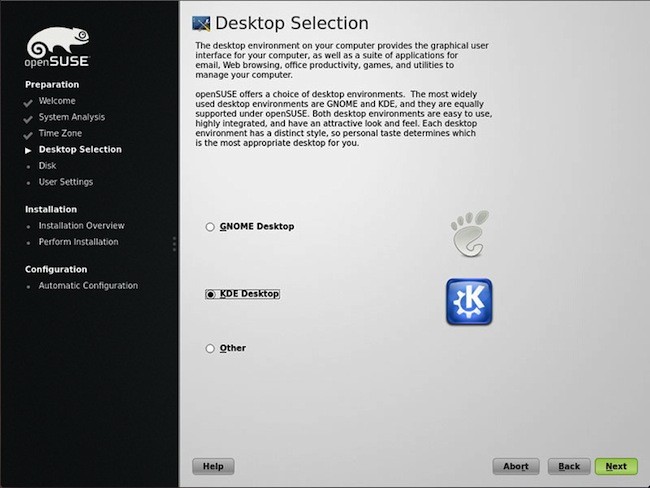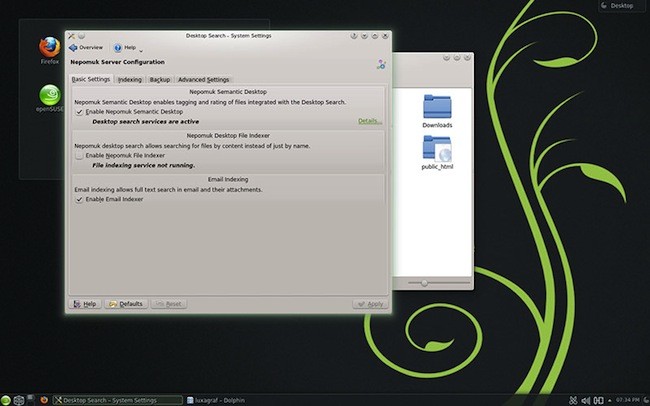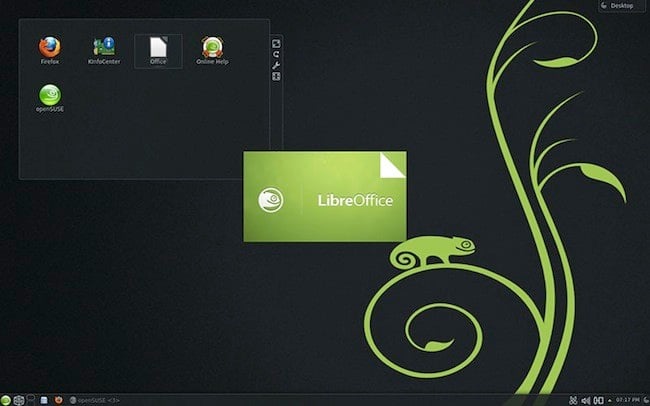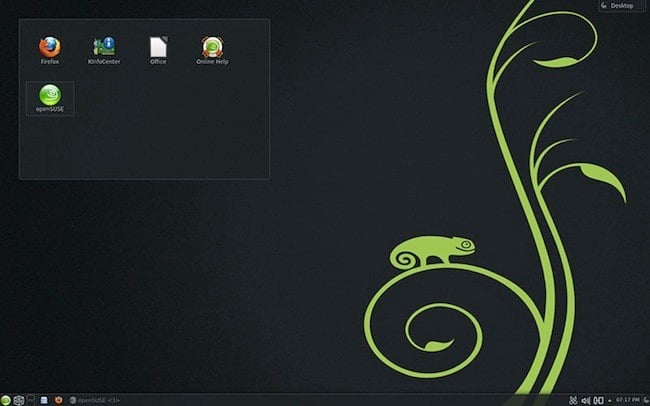Original URL: https://www.theregister.com/2013/03/15/suse_linux_12_3_review/
OpenSUSE 12.3: Proof not all Linux PCs are Um Bongo-grade bonkers
KDE looks slick, stuff works, no Ubuntu-style ad-ware
Posted in OSes, 15th March 2013 11:24 GMT
Review The openSUSE project is back on track. This week version 12.3 of the Linux operating system distribution was unleashed, right on time, as a free download.
This will be seen as good news after the organisational restructuring and delays that plagued the release of openSUSE 12.2 last year.
While 12.2 was delayed, it was worth the wait, delivering a snappy, attractive and, perhaps most importantly, stable KDE desktop alternative to a world drowning in desktop "innovation".
The latest openSUSE is no different and while the open-source project is often at pains to label itself desktop agnostic, going so far as to completely support GNOME, KDE, Xfce, LXDE and even the brand new Enlightenment 17, KDE remains the default choice on the install DVD and my recommendation for anyone wanting to try out openSUSE or KDE.
The installation screens remain some of the nicest you'll find in a Linux distro, offering a simplified interface that gives you a good bit of information about what's being installed on your system. Finding the balance between simple and simplistic isn't always easy and openSUSE's installer does a good job of walking that line. It also defaults to putting your home directory on a separate partition, a nice touch savvy users are probably already aware of, but which Linux newcomers may not otherwise do.
It's also worth noting that the openSUSE 12.3 installer should play nice with UEFI and Secure Boot.
If you stick with the default KDE install you'll find that openSUSE 12.3 has done a little KDE leapfrogging, skipping over KDE 4.9 - which just narrowly missed shipping with openSUSE 12.2 - to deliver the recently released KDE 4.10.
KDE 4.10 doesn't pack in the new features; unlike GNOME or Unity, KDE 4 has reached a level of maturity where the primary focus is on speed in incremental improvements rather than a constant barrage of new features - but it does offer several speed improvements that help make openSUSE 12.3 feel a bit faster even than its speedy predecessor.
Chief among the improvements in KDE 4.10 is an overhaul of NEPOMUK, the document search tool that aims to make KDE the "Social Semantic Desktop". Strip away all the hype and what NEPOMUK really does is provide a much better way to find your stuff. It's very much a work in progress, but KDE 4.10 sees NEPOMUK cleaning up its act when it comes to memory use.
Changes under the hood should mean NEPOMUK indexing no longer grinds your desktop to a virtual stand-still. The initial indexing still takes some time, but in my testing the changes seem to make NEPOMUK work quite well, eliminating the need to limit the amount of memory NEPOMUK can use - greater control over the software can be found by heading into the Desktop Search settings panel.
KDE 4.10 also brings a few updates to common KDE apps such as KMail, which features a smarter quick search tool that scans the full content of your email. The Okular PDF viewer has also been updated as have other KDE standards, including Kate and KWrite. OpenSUSE also includes some extras in its KDE setup (provided you install from the DVD), such as the photo editor Showfoto, as well as non-KDE apps including Firefox and LibreOffice, both of which are somewhat nicer than the default KDE offerings.
It's worth noting that openSUSE has opted to stick with LibreOffice 3.6, though if you simply must have the recently released 4.0 you can install it yourself.
GNOMES sneak past the dark-side of KDE
As with the previous release, the default KDE desktop theme for openSUSE is one of the nicest you're likely to find. This time around, the look has been tweaked to make things a bit darker, which doesn't feel quite in keeping with openSUSE's image, but perhaps that's part of the "finding a new direction" goal that was part of last year's project restructuring.
Whatever the case the new darker desktop is still a thoroughly well-designed theme that even manages to make non-KDE apps such as Firefox or image editor GIMP feel like a natural part of the KDE desktop.
If KDE is your desktop of choice, openSUSE 12.3 is well worth at least a test run. Not only is it speedy, it's the best looking default KDE desktop you're likely to find. If you like to tweak your desktop to get it just so that may not matter much, but if you prefer to leave things as they are and just want a nice looking theme while you work, openSUSE 12.3 makes a slick choice.
Under the hood, openSUSE 12.3 updates to Linux kernel version 3.7, which has quite a few new features, including updated driver support for Nvidia graphics, better virtualisation support and some optimisations that should make Linux play nicer with the still-experimental file system Btrfs. This release is also among the first to work on ARM-compatible chips. Enterprising users have already managed to get openSUSE running on Google Chromebooks.
If KDE is not your bag, fear not: openSUSE has a nicely themed GNOME desktop release as well. The GNOME shell version of openSUSE ships with GNOME 3.6 this time around. GNOME 3.6 is old news at this point, especially with 3.8 just around the corner, but if you're upgrading from openSUSE 12.2, it's well worth the update and continues to improve on the radical rewrite that is GNOME 3.
This version sees a number of new features, such as an Apple Expose-style tool to reveal thumbnails of all the open windows, and a streamlined Nautilus file browser that offers a new menu for quickly getting hold of recently opened documents. GNOME 3.6 also brings a full complement of upgrades for bundled GNOME apps.
The openSUSE project also supports both the Xfce and LXDE desktops, with the former also serving as the stripped down desktop for the recovery CD.
Back when openSUSE 12.2 was released I wrote that the distro felt caught between worlds, with one foot still in the enterprise (it is, after all, connected to SuSE Linux Enterprise Desktop) and one foot in the consumer desktop space. To some extent openSUSE still feels that way, although it also feels like it's beginning to find its way and that the pendulum is swinging more toward the consumer desktop side of the equation. Not necessarily at the expense of openSUSE's enterprise tools though, which, like YaST, remain a part of the distro.
In fact, the server side of the chameleon has some great new stuff as well. Chief among the updates is a new version of cloud-hosting favourite OpenStack, which first shipped with openSUSE 12.2. Other updates include the latest version of Gnome Boxes for managing virtual machines, as well as updates for databases including PostgreSQL.
OpenSUSE may not get the press coverage that rival Linux distro Ubuntu manages - what with its ad-ware controversy - and I wouldn't expect to see an openSUSE phone or tablet any time soon. But openSUSE does offer a rock-solid release that's well worth considering, especially if you're a fan of the KDE desktop. ®



